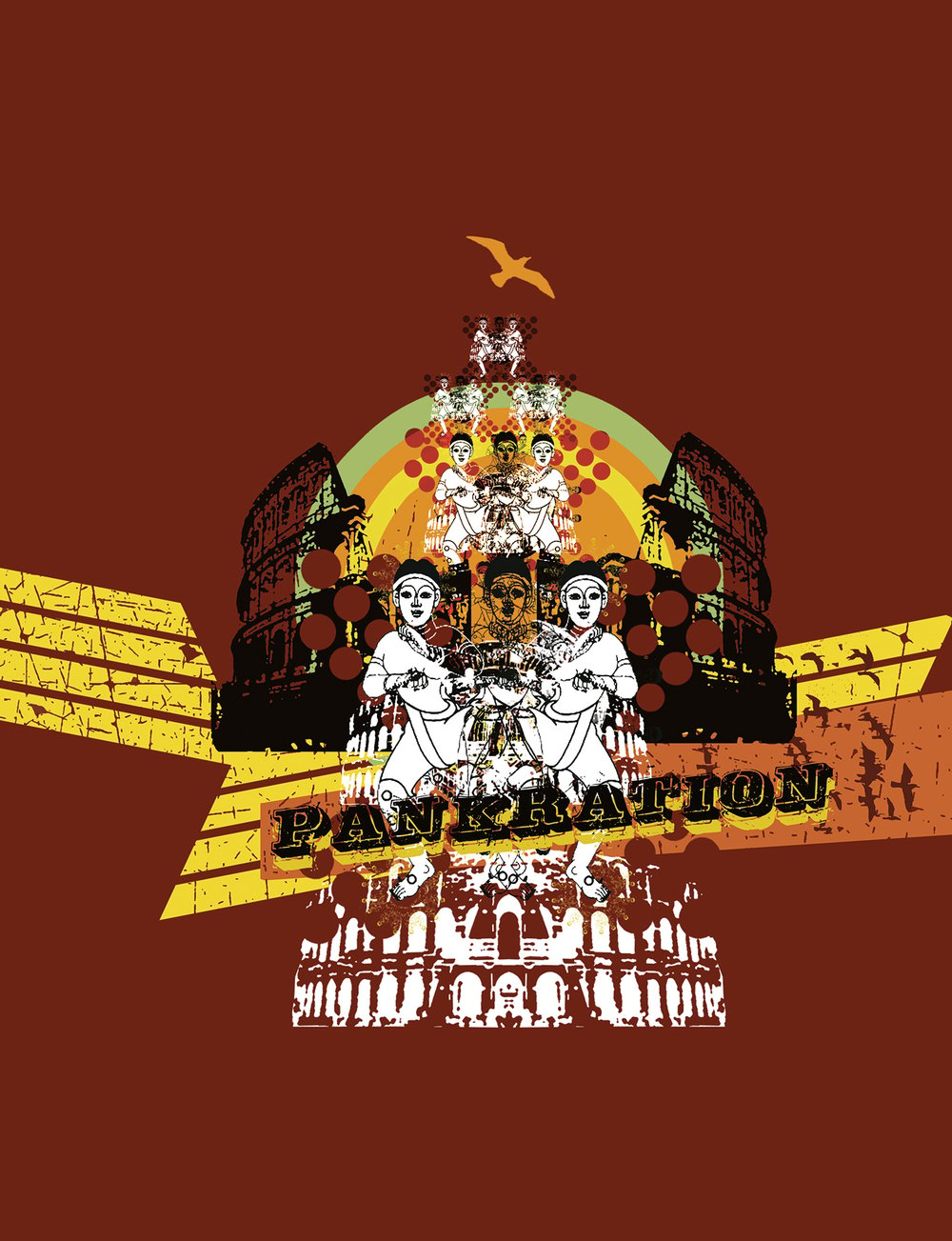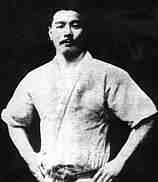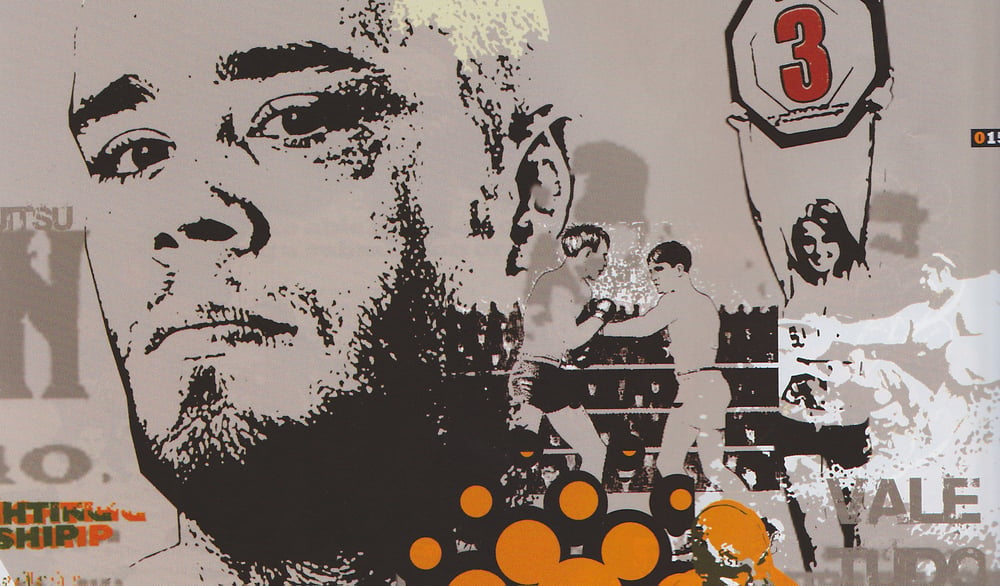
Issue 001
February 2005
They say history has a habit of repeating itself. They also say there is nothing new in the world. Not to mention that what goes around comes around. Regardless of what people may try to tell you, it’s clear that some things have been around longer than you may realize.
In the case of the dynamic new sport Mixed Martial Arts (MMA), all of the statements overleaf are accurate. Many participants, enthusiasts and spectators of MMA consider it to be a truly modern form of combat sport, one fit for a new millennium and a refreshing alternative to sports such as boxing, kickboxing or wrestling.
The widely distributed videos of the early Ultimate Fighting Championship (UFC) events were almost entirely responsible for introducing a generation of athletes to the newest and most exciting sporting phenomenon to hit the planet. Yet, unbeknown to the many who have become intoxicated by the thrilling spectacle of witnessing two men in no-holds-barred combat, MMA is actually one of the oldest combat sports known to man.

Sport fighting in early civilizations
The ancient Greek sport of Pankration is the earliest recorded form of combat that resembles MMA. Opinions differ, but it is thought Pankration began sometime between 700 and 650 BC. While no trusted written accounts remain, archaeologists have uncovered vases and other pieces of pottery that depict combatants engaging in a sport that included bare-knuckle punching, kicking, grappling, and finishing holds. Pankration featured alongside boxing and wrestling in the ancient Olympics and was far different to its modern descendant.
Competitors fought naked, and it is said the only rules were no biting or eye gouging, although it is uncertain how strictly these were enforced. It is known that referees held sturdy sticks and would beat the fighters if rules were breached or they were not displaying enough activity. While concussive blows were a popular means of victory, it is said that finishing holds played a far greater part in deciding contests. Contests had no weight categories or time limits and while submission was a way of acknowledging defeat, bouts occasionally resulted in injury or even death.
While seemingly brutal and uncivilized, Pankration was held by many high-ranking personages within Classical Greek society to be the most elegant form of combat, due to its versatile nature and the high level of grappling skill displayed by its practitioners. Stories abound of the contests involving famous athletes such as Arrichion, Dioxxipus and Polydamos. All were fighters who made their name in the Pankration arenas and found themselves lavished upon by their patrons in a way that would make modern athletes jealous.
In time, the conquering Roman Empire assimilated Pankration and turned it into something far more deadly by introducing the Caestus, brass knuckles bound to the fists with leather thongs. These deadly weapons meant that the competition increasingly resembled the more popular forms of gladiatorial combat and the death of competitors was now encouraged rather than an unfortunate consequence. Ever-more bloodthirsty crowds demanded further bloodshed and soon the Caestus was replaced with spiked gloves and, later, edged weapons. Pankration now no longer existed and it remained this way for almost two thousand years.
As Christianity spread and engulfed the Holy Roman Empire, gladiatorial combat become increasingly unfashionable and was later outlawed. The dark ages and medieval times followed, and as kings and lords across the world busied themselves with making war, few records of sporting competitions exist.

Pugilism and the birth of modern prizefighting
Apart from the military methods of combat necessary for survival in a turbulent world, almost all cultures throughout time have had some form of indigenous fighting art. Usually, this is a form of wrestling and in the British Isles many regional variations existed. However, the ability to wrestle requires skill and knowledge — consequently, for many ‘untrained’ fighters it is far more natural to use their limbs to strike an opponent. Even so, wrestling competitions were held up and down the country at fêtes and festivals, but no record of prizefighting existed until a London newspaper reported on a pugilistic contest in 1681.
Before the introduction of the Marquis of Queensbury rules, pugilism more resembled MMA than its modern equivalent of boxing, although the ‘rules’ enforced made it a closer cousin to Pankration. Indeed, it is unclear if rules were enforced at all, as no written guidelines existed. All manner of attacks were reported to have been used by pugilists, including eye gouging, hair pulling and the twisting of ears and fingers. Both kicking and wrestling an opponent was allowed, as was throwing him to the ground and striking while upon the floor. Whether a system of submissions was developed to rival those of the Ancient Greeks is unknown, but considering the bloodthirsty nature of these battles it is highly unlikely.

The most famous pugilist of this period was James Figg, a prizefighter who opened a highly popular academy of combat in London. Undefeated for 11 years, he was in many ways an old-fashioned version of an MMA fighter, as he was a skilled wrestler and fencer as well as striker. He taught all aspects of hand-to-hand combat at his school, alongside the popular weapons of the day such as the cudgel and staff.
While it was Figg who was first credited with taking pugilism away from resembling a simple brawl and injecting it with a degree of technique, a later champion named Jack Broughton developed what is thought to be the first scientific system of blocks, parries and counters that would go on to become modern boxing.
As well as lending his name to the first set of written rules, Broughton did much to further the acceptance of fighting within gentile society. Partly due to his gentlemanly behavior and educated background, but also to his sound business sense and formidable skill, he enjoyed patronage from many members of the upper classes. As his rules became more commonplace, kicking or using ‘dirty’ tactics on an opponent was deemed less and less acceptable (although wrestling and throwing one’s adversary was commonplace for far longer). Prizefighting eventually became the sport of boxing through the introduction of ‘mufflers’ — or gloves — and the creation of the Queensbury rules.
Traveling carnivals and challenge matches
The 18th-century equivalent of MMA may have died out, but it resurfaced in the form of carnival challenge fights. For much of the 19th and early 20th century, traveling carnivals held wrestling matches between athletes. These were usually decided by the pinning of a man so that both his shoulders were touching the mat, but a highly popular offshoot came into being when challenge matches were offered to the public.
For a chance to win a small cash prize, the public was offered to try their skill against these traveling wrestlers. However, it was not uncommon for the punters to play dirty, and in response, the wrestlers used a system known as ‘hooking’. Painful cranks and holds were used to make a punter submit and forfeit the match. However, even with their submission skills, wrestlers had to be ready to deal with an opponent who would strike rather than wrestle. As a result, these early ‘catch-as-catch-can’ wrestlers were in many respects another version of MMA fighters, as their skill involved fighting in more than one discipline.
Increasingly, the outcomes of carnival catch wrestling matches became fixed and it eventually became a ‘show’ rather than a contest. ‘Professional’ wrestling all but destroyed the true fighting roots of catch wrestling, although it has enjoyed a rise in popularity in recent years and is considered a strong part of some modern MMA fighter’s arsenals.
The Olympics return — but without MMA
Around the time of the heyday of the carnival wrestlers, a young Frenchman called Pierre de Coubertin had the idea of reviving the Olympic games. While not the first to suggest doing so, he managed to rouse interest from various parties and succeeded in spurring the formation of the International Olympic Committee (IOC).
The first modern Olympics were held in Greece in 1896 and though the ancient Olympics sport of wrestling featured in the program (boxing was introduced two games later in 1904), Pankration did not. It is said that the organizers thought it would not be accepted by the conservative society of the time, however, there is little evidence to support this and it is more likely that it was not included through ignorance and lack of knowledge of the existence of such a sport (not to mention competitors!).

Eastern promise
While Western culture focused upon the sports of boxing and wrestling, halfway around the world there was another, altogether different type of revolution happening to the fighting arts. In Japan, a man named Jigaro Kano was formulating a plan to unveil his art of judo to the world, little knowing he would have a direct influence in the development of what would become modern MMA.
With intentions of making his fighting art the most popular form of combat in the world, he sent representatives of judo around the globe. But whatever plans Kano had for judo and martial arts, he would never have imagined the revolution that resulted from a meeting between his emissary Mitsuyo Maeda (latterly known as ‘Count Koma’) and a family of diplomats called the Gracies.
Judo is exported to the world and reaches Brazil
Judo is one of the most widely practiced sports on the globe and it has been an Olympic sport for more than 50 years. All this could only have been made possible thanks to the sheer determination of Kano to give' Judo to the world. Kano was a government official of some rank who used his connections throughout the political and social society to introduce Judo into the public school curriculum. His masterpiece, though, was to dispatch a selected group of ambassadors to various countries throughout the world and establish an international network of Judo clubs.
One such emissary was the now-legendary Mitsuyo Maeda. Working for the Japanese government, he traveled to Brazil and there he came into contact with the Gracies. Maeda began teaching Carlos and Helio Gracie what the family now claim was Jiu- Jitsu, but in reality what was more likely an undiluted version of the original (and not modern sporting format) Judo.
Arguments rage to this effect, as the Gracies are obviously keen to point out that their art is a pure form of Jiu-Jitsu but are loathe to draw comparisons or attribute any part of its development to the rival art of Judo. Truth be told, traditional Japanese Jujutsu begat Judo, and in part, Judo had a major hand in shaping the development of what is now known as Brazilian Jiu-Jitsu.
Gracie Jiu-Jitsu and Vale Tudo
The Gracies were keen to showcase their art to a wider audience and a popular attraction in the 1920s and 30s Brazil was the spectacle of 'Vale Tudo'. A phrase coined by a newspaper reporter, Vale Tudo meant 'anything goes', and was a contest fought under rules rarely seen at that time in history.
Similar to the medieval boxing fights mentioned in the previous article, Vale Tudo fights were raw and often brutal contests that pitted bare-knuckle fighters against each other with limited rules in force and without the luxury of time limits or referee interventions.
The fighters of the early Japanese promotions were well-rounded athletes who could strike, wrestle and submit. Fighters such as Genki Sudo, Kazushi Sakuraba and Takanori Gomi are all excellent examples of the current generation of Japanese fighters who are able to fight comfortably in every range.
Many MMA fans describe it as the purest form of combat there is, though it is not for the faint-hearted. The passionate Latin personality loved these events, and they soon became highly popular, selling out large stadiums and attracting vast crowds. Bouts could at times last for hours and, interestingly, most were won and lost not due to stand-up striking techniques but by grappling techniques.
Various members of the Gracie family have fought under these rules throughout the last 80 years and have shown time and time again that the ground-based grappling aspect of Jiu-Jitsu (designed with the intention of fighting a larger, stronger opponent) has always proved to be a highly useful skill to have during a fight of this sort. Making use of the principles of leverage, superior technique over strength and employing a clever positional strategy, Brazilian Jiu-Jitsu (BJJ) has Royce Gracie made itself an indispensable part of any fighter's arsenal.
Vale Tudo fights existed in Brazil until very recently. Bare-knuckle tournaments were popular right into the 1990s, and Brazilian MMA events are still often fought under less stringent rules than other countries. Due to the lasting legacy of the Gracies, BJJ and MMA are highly popular sports in Brazil, and some of the world's greatest fighters hail from there. World champions Wanderlei Silva and Antonio 'Minotauro' Nogueira are recognizable to almost all MMA fans worldwide.

MMA behind the Iron Curtain
Brazil can lay claim to producing some of the greatest fighters in the world, however, it is wrong to assume that the history of modern MMA relies solely on Brazil. While it has evidently been involved far longer than any other country (Western nations. were far too preoccupied with established combat sports such as boxing, wrestling and even Judo), there were other nations that were busy holding competitions that have all had an effect on the development of MMA.
In the early 20th century, the Soviet Union had developed a grappling-based system called Sambo. Largely unknown to those on the 'free' side of the Iron Curtain, it was a synthesis of many different national wrestling styles blended with Judo and Karate and tailored specifically for military use and self-defense. They had, in effect, created their own form of MMA and were busy testing it in military institutions throughout the land. Competitions between soldiers are held behind closed doors within armed forces facilities and have been for some years.
Since Russia opened its borders a swathe of Russian fighters who cut their teeth in these events has entered MMA competitions, surprising the world by performing so well so soon. While traditional stylists struggled to cope with the advances in training required to compete in MMA, the blend of Sambo combined with striking arts such as boxing and kickboxing has proved to be extremely formidable, and it has paved the way for many great Russian athletes to enter MMA. Versatile and exciting fighters seem to emanate from the former Soviet Union - Igor Vovchanchin, Fedor Emelianenko and Andrei Arlovski all spring to mind.
The Rings of Japan
The birthplace of Judo and Karate cannot always have claimed to be at forefront of MMA, but they pre-empted the explosion of interest in the West in the 1990s with their limited-rules, mixed-style competitions. The former pro-wrestler Satoru Sayama held the first Japanese MMA event in 1989; one-time colleague and former pro-wrestler Akira Maeda created a similar style of fighting called Rings in 1991; and Masakatsu Funaki and Minoru Suzuki launched their 'hybrid submission fighting' event, Pancrase, in 1993.
All of these events were fought under what now seem highly restrictive rules. Open hand strikes and kicks were allowed and standing, grappling and fighting for submissions was permitted, but striking while on the floor was not. With the added element of shin pads, the early Japanese competitions were very different to modern MMA. Fighters had to adapt to work around the rules put in place. A new generation of submission-orientated wrestlers was born. Very different to the Jiu-Jitsu-based practitioners, they derived their style from the old-school Catch wrestlers, because European Catch wrestlers such as Karl Gotch had been brought to Japan to teach.
The fighters of the early Japanese promotions were well-rounded athletes who could strike, wrestle and submit. Fighters such as Genki Sudo, Kazushi Sakuraba and Takanori Gomi are all excellent examples of the current generation of Japanese fighters who are able to fight comfortably in every range.
Traditionalists get a rude awakening
Many members of the Gracie family had moved to the USA during the 1980s. BJJ was slow in taking off there and lessons were being taught out of a garage at Rorion Gracie's house in Los Angeles. The Ultimate Fighting Championship (UFC) was originally devised as a showcase for BJJ. Due to the vice-like grip Kung-Fu, Karate and Tae Kwon Do had on the US consciousness, Rorion thought it time to awaken the minds of the nation by exposing one or two myths.
When shown the reality of how a fight under MMA rules can be won, people sat up and took note that to be a good fighter, you had to be well-rounded. So-called martial artists took a severe blow to their credibility as Rorion's younger brother Royce dominated his way on the mat and went on to win the UFC. The floodgates had been opened for a generation of athletes to begin cross-training.

The era of cross training
A massive evolution in unarmed combat has taken place in the last 12 years. More has changed in recent times than in the last millennium. We have witnessed the beauty and effectiveness of the technique of BIJ as it has cut a swathe through uneducated strikers. Wrestlers came from nowhere-so physically dominant and aggressive that they were able to pin an opponent and strike away until forcing a submission or stoppage. Strikers became savvy to the strategies of the submission artists and the Ground 'n' Pounders, and with a rudimentary knowledge of the ground game, they managed to survive long enough on the ground to get back to their feet to score a KO.
The realization that all fighters must be well-rounded was a quick one. Nowadays, all MMA fighters must cross-train in the areas of striking, grappling, and submissions. But this doesn't mean they can't have a preference. The emergence of distinct strategies has been evident in recent times and these can be categorized into three main (but not wholly encompassing) styles:
- The Striker: either a natural striker or someone with a long background in striking competition, they are often referred to as a 'sprawl and brawl' fighter. Their strategy will be to remain standing so that they can use their preferred weapons of fists, knees and feet. They will train extensively in stopping the takedown or getting back to their feet if they find themselves on the mat. Examples of fighters using this strategy: Chuck Liddell and Mirko 'Cro-Cop' Filipovic.
- The Wrestler: normally known as a Ground 'n' Pound fighter, their whole objective will be to get their opponent on the floor and, once there, to attack them from top position. Either working for a TKO stoppage or submission, they will punish and wear down their opponent with strikes until the contest is over. Examples of fighters using this strategy: Randy Couture and Tito Ortiz.
- The Submission Artist: will take down, control and submit an opponent by whatever means necessary. Able to fight from top or bottom position, a good submission fighter will always be on the lookout for a chance to tap you out and can do so in the blink of an eye. Examples of fighters using this strategy: Antonio Rodrigo Nogueira and Frank Mir.
The X Factor
MMA fighters may have their preferences, but the recent trend is for fighters to be so well-rounded you cannot pigeonhole them into one style. Grapplers are winning fights by KO and renowned strikers are winning fights with submission techniques. With this in mind, it is worth considering that you are only as good as your weakest area, which in the sport of MMA can be exposed in a heartbeat. Gone are the days of pure wrestlers and gone are the days of strikers who had never been off their feet.
Who knows what the next development in MMA will be? To think that all possibilities have been covered would be foolish - as the lessons of history have taught us, things change and if you let things change around you, you will find yourself left behind. What that means is we can expect many exciting developments in MMA competitions around the world very soon! Watch this space for details.










